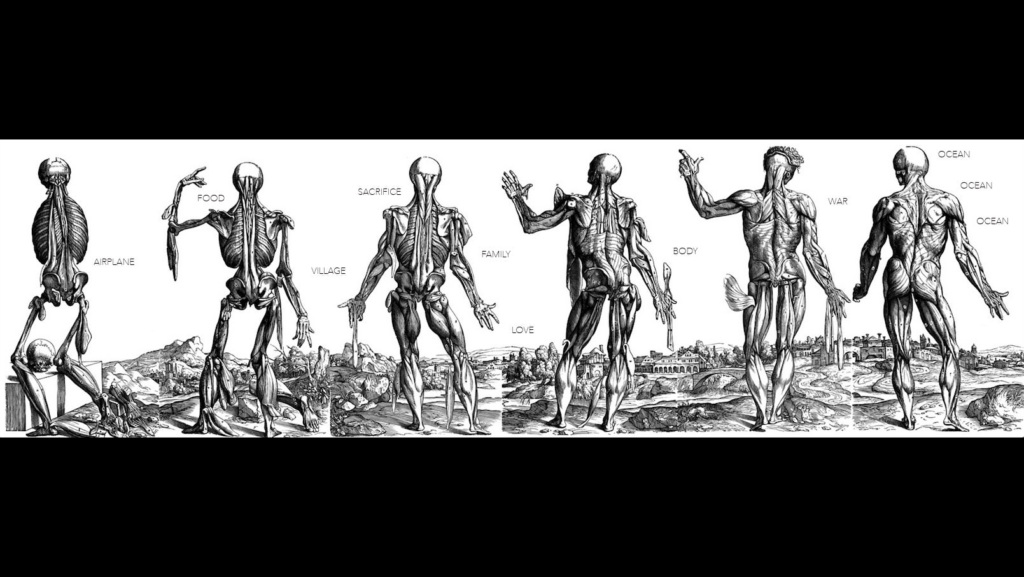During What Now? the 2021 HPG Symposium, we charged three artists to collaborate with grad students to create new works based on their original scholarship. The artist/scholar pairs met for two months ahead of the symposium and then debuted their work to a live audience. Read about each of our contributors and see their art below.
Aunt Molly Jackson
Iris Gottlieb is an illustrator and author best known for using art to demystify complexities of history, science, sociology, and her own experience. Passionate about race and gender equity in classical music, Elias Gross comes to UNC with a background in arts administration, music education, and viola performance. Gross is currently studying the life and music of Aunt Molly Jackson, a feminist icon and folk hero, on which Iris’s illustration is based.
Solastalgia
Kamara Thomas is a singer, songspeller, mythology fanatic, and multidisciplinary storyteller based in Durham, NC. Deanna Corrin is a PhD student in Geography studying feminist political geography, health geography, political ecology, and wildfires. The music and visuals Kamara devised bring Deanna’s work on the devastation of the Paradise wildfire into perspective, capturing the concept of solastalgia: emotional distress from environmental change.
Nervous Endings
Jessica Q. Stark is a mixed-race poet and scholar that lives in Jacksonville, Florida. Jacob Griffin is a PhD student in Anthropology on the Biology, Ecology, and Evolution Track. He studies the deterioration of physiological functions associated with advancing age due to inflammation dysregulation. The poem and accompanying art Jessica created beautifully folds Jacobs research into her own creative work about the body and her mother’s life. Read it below.
Nervous Endings
Eros is everywhere. It is what binds.
—John Updyke
She’s young in age but knows her sage
She knows a page or two from the book of the luck
—Princess Nokia
Like a probable god, I am
the archetype of a shape
small desires at the end
of my arms and nose
of houses and undone
hours against bone
This is a memory test. I am going to read a list of words
that you will have to remember now and later on. Listen carefully.
When I am through, tell me as many words as you can remember.
It doesn’t matter in what order you say them.
Village-Love-Body-Airplane-War-Sacrifice-Ocean-Food-Family
What happens against
a body occupied
a clock’s antidote to
a gone-village, gone
home for dispersion—
an absence, a little
string laid out
on life’s plank
on the phone
my mother worries
about her death, what
time it will be
who will care
who will take
she drinks
green tea against life’s
petty inflammations
childhood of rice
childhood of smallpox
of dirty water
and dead brothers—
her mother’s infection
impressing upon the
fabric of her body
like loose thread
I’m older now, she says
a little incantation as
permission to stay
stone-still against
memory’s stable—
the food between us
that she lets rot
I am going to read the same list for a second time.
Try to remember and tell me as many words as you can,
including words you said the first time.
Family-Sacrifice-Love-Village-Airplane-Ocean-Food-Body-War
What of a village?
My mother left
an airplane
and returned twenty
years later to a hole in
her body, my body
like a net of
decisions unmade
you can resist death,
but you can’t refuse
water—can’t garbage
a little white lie
she says the first time
she saw the ocean
she was up so high
moving away
from every
known word
through blue sky
she moves slower
now and dyes her hair
weekly against
love’s firmament
what is an age,
but accumulation,
but a finite template
for life’s choices—
to move,
to be still,
to love plainly,
or to survive
I will ask you to recall those words again at the end of the test.
Airplane-Food-Village-Sacrifice-Family-Love-Body-War-
Ocean
Ocean
Ocean
– – –
Notes:
This poem was written in collaboration with Jacob Griffin’s research on inflammation, pathogen exposure, physical activity and aging from his dissertation, “The Role of Adiposity Induced Inflammation in Biological Aging.”
The questionnaire language is extracted from the Montreal Cognitive Assessment (MoCA) Administration and Scoring Instructions.
Annotated illustrations are woodcut excerpts from “De Humani Corporis Fabrica Libri Septem” (“On the fabric of the human body in seven books”) written by Andreas Vesalius and published by Johannes Oporinus in May 1543. One of the earliest accounts of anatomical illustrations, these woodcuts were recompiled as a “six-series” side-by-side by Harvey Cushing in “A Bio-Bibliography of Andreas Vesalius” (1943).


